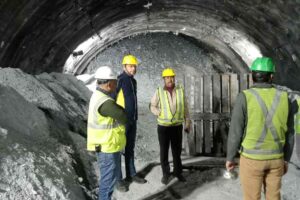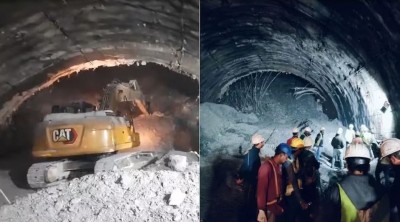The collapse of the Uttarkashi tunnel ignites a discussion about “unchecked development” in the hills. Authorities in Uttarakhand’s Uttarkashi are putting up a lot of effort to guarantee the prompt evacuation of forty workers who are buried beneath the wreckage of the collapsed under-construction tunnel.
The rescue effort, however, is beset by severe topographic difficulties, particularly since activities were impeded by debris from a landslide that landed over the collapsed portion of the tunnel that was still under construction.
Following the tunnel disaster, eminent Uttarakhandi geologist MPS Bisht said, “When undertaking such massive engineering projects, it is of utmost importance to conduct thorough geotechnical and geophysical mapping of the specific rock on which the tunnel is to be constructed.”
Before starting any infrastructure project in a mountainous environment, this activity is crucial. Because rock conditions can change throughout construction, it is essential to continuously monitor and enforce safety precautions. The quality of the rock on the other side of the hill can be learned by geophysical mapping,” he continued.
According to experts, building in the vulnerable mountains calls for specialized knowledge and cutting-edge equipment. This begs the question of why state authorities approved such large-scale infrastructure projects without considering the conditions of the Himalayas, especially in the Uttarakhand range.
MPS Bisht comes to the conclusion that this isn’t the case in this instance.
Similarly, environmentalist Anil Joshi said, “This incident seems to be attributable to a lapse from the construction company given the numerous devastations the state has witnessed in the last decade alone.” It’s possible that problems like unfinished plastering were not sufficiently addressed as the project moved forward.”
He emphasized that when developing infrastructure, it was imperative to take climate change and the geological features of the delicate Himalayas into consideration.
Notably, on October 28, in Uttarakhand, a seminar on climate change and sustainable development covered this topic in great detail.
A member of the Uttarakhand Pollution Control Board named SK Patnaik stated during the seminar that “unchecked development” was occurring in the hills.
“Regulations on Extended Producer Responsibility exist, but they are not being observed. In order to ensure sustainability, we must give up comfort and material possessions. A shift in lifestyle is essential,” he declared.
In a similar vein, scientist Dr. Poonam Gupta of the Uttarakhand State Council for Science & Technology stated that in order to examine sustainable pilgrimage, studies must be conducted to determine the quantity of water that is accessible and the number of establishments—businesses, buildings, etc.—that can comfortably accommodate a particular number of visitors without endangering the local ecosystem of these holy sites.






























